Exercise and advice after gynae surgery
 These exercises are recommended by the
physiotherapist. If possible, practise them before your
operation so you can get used to doing them.
These exercises are recommended by the
physiotherapist. If possible, practise them before your
operation so you can get used to doing them.
Early exercises
Repeat the next exercises at regular intervals
until you are up and walking about as
usual.
Leg exercises
Move both feet up and down briskly at the
ankles. Press back of knee down onto the
bed tightening the front of thigh
muscles. Hold for five seconds then relax. Repeat with other
knee. Move each foot alternately up and down on the bed,
bending your knee and keeping your heel on the
bed.
Remember - try not to cross your legs as this can slow
down your circulation.
Breathing exercises
These will help clear your chest of any
secretions. Start your breathing exercises as soon as
possible. Take a deep breath, fill your
lungs with air then gently breathe out. Repeat at
regular intervals until you are up and walking about as
usual.
Coughing
If you have any secretions (phlegm) you
will need to cough effectively to clear
your chest. Sit forward with your knees bent and support your
wound with your hands or a pillow.
Take two to four deep breaths then cough and spit any mucus
into a tissue. Repeat as often as you feel
necessary.
Huffing
This is useful if you find it difficult to cough
effectively. Take a medium size breath in
and then breathe out fast through an open
mouth, using your stomach and chest muscles. This will squeeze
sputum along the airways to a point where you can cough it up.
(Imagine steaming up a mirror).
Back care
Whether you are in bed or a chair make
sure your back is well supported. Placing
a small pillow or roll in the small of your back may increase your
comfort and help to prevent backache. When turning over in bed have
your knees bent and try to roll over
without twisting. Try to always walk tall, without stooping. It
will be more comfortable and will help to protect
your back.
Getting out of bed
Bend both knees, roll over onto your
side, keeping your knees together.
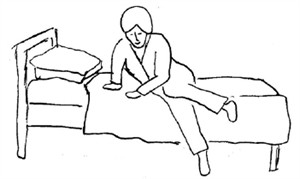
Push yourself up into a sitting position with your elbows
and hands allowing your legs to swing
to the floor. Stand up
slowly.
When getting back into bed sit close to
the bed's back support and reverse the above
process.
Early exercises from the second or third day
Important - when doing these exercises do not hold your
breath.
Listen to your
body:
- stop if it
hurts
- stop if
tired
- never exercise if feeling
unwell
Gentle abdominal exercises
Repeat each exercise about
three times, approximately two to
three
times each
day.
Try to continue doing them
when you get home.
Tummy toner
This early abdominal
exercise can be done lying on your back with your
knees bent (as shown in the exercise 'pelvic tilt') or, if
comfortable, lying on your side with a pillow between your knees,
as shown below.

Gently draw in your lower tummy muscles and hold for
3-10 seconds. Repeat up to 10 times. Do not hold your
breath.
Pelvic tilt
Lie on your back with your knees bent and pull
in your tummy
muscles.
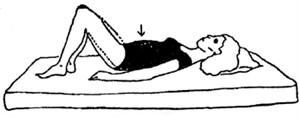
Press the small of your back into the bed and
tighten your buttocks.
Hold for a few seconds then slowly let go.
Knee rolling
Lie on your back with
your knees
bent.
Pull in your tummy
muscles and take both knees to the right
side - just as far as is comfortable - this involves
raising the left hip off the
bed.
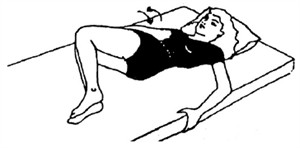
Back to
the middle and
rest.
Then repeat
on the left
side.
The two
above exercises can help relieve 'wind' and
backache.
Repeat five times, twice a day,
if comfortable.
Pelvic floor exercises
If you have had a
vaginal repair operation, check with the
physiotherapist on the ward when you should start this
exercise, otherwise start gently when
comfortable.
Do not start this
exercise if you have a urethral
catheter.
Wait until it is removed
and you are passing urine
normally.
The pelvic floor
muscles are a sling of muscles which pass from
the base of the spine forward to the pubic bone at the front. There
are openings for the bladder, vagina and bowel. These muscles
support the pelvic organs.
To exercise these muscles:
Close and draw up the front and back
passages.
Hold for as long as you can then let
go.
Rest (for approximately four
seconds).
Repeat as many times as you can.
Now do several short quick
contractions.
When doing the above exercises do not:
Hold your breath.
Squeeze your legs or buttocks
together.
At first do the exercises in bed, then later they
can be done while sitting or standing
with your knees slightly apart. If the
pelvic floor muscles become stronger they will give
better support for your bladder and bowel and
help you maintain control.
Important - this is an exercise which you should never
forget to do. Aim to carry on with these exercises after leaving
hospital and then try to continue them several times a day for the
rest of your life.
Stronger abdominal exercises
Approximately 4-6 weeks after your
operation, start these exercises when you feel ready. Do them on
a carpeted floor or a firm bed with
a pillow under your head. Repeat each
exercise about three times, slowly building
up to 10 times, twice a day. These
exercises should not be painful. If they are,
leave them until you can do them
comfortably.
Head and shoulder raise
Lie on your back with your knees bent
and a pillow supporting your
head.
Pull your tummy
in.
Tuck in your
chin.

Lift your head and shoulders and slide
your hands towards your
knees.
Lower slowly back to
finish.
Rest and repeat
Head and shoulder raising with diagonal movement
Lie on your back with your knees bent and a
pillow supporting your
head.
Pull your tummy in.
Tuck in your chin.
Reach with your right hand diagonally across
your body to your left hand. This
involves lifting the shoulders of your right side up off the bed as
well.
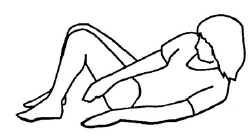
Make sure it is your tummy muscles working,
not those of your
shoulder.
Back to the middle and
rest.
Repeat on the other side.
General guidelines
Listen to your body. Treat the
first two weeks as a
convalescence. You can make a cup of tea and do easy
housework such as
dusting.
It is quite safe for you to go up
and down stairs from the day you go
home.
Housework and lifting
Try to avoid any heavy
lifting for several months after
your operation. This includes - heavy shopping bags,
wet washing, full saucepans, the hoover, the ironing board. When
you do lift remember to do it
correctly:
- Bend your
knees.
- Keep your back
straight.
- Pull in your
tummy.
- Pull up your pelvic
floor.
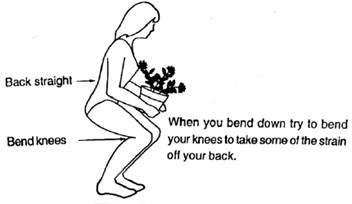
Driving
Do not drive until your feel
confident to do an emergency stop.
If you have had abdominal surgery, we advise you not to drive for
four weeks. Check with your insurance company for any
specific regulations.
Back to work
The doctor will advise you when to
return to work. It may be any time between 6-12 weeks
depending on the type of surgery you have had, the rate of your
recovery, the type of work you do and the amount of travelling
involved.
Exercise
Walking is an ideal
exercise. When you feel ready you could
aim for a daily walk of 10 minutes which can be
increased gradually. Try to find time
each day to do your exercises. Remember to keep up the pelvic floor
exercises once or twice a day for
'the rest of your
life'.
Gentle swimming for pleasure
could be started at 4-6 weeks
providing any discharge has stopped. A gentle return to
sporting activities is essential. A guide would be
8-10 weeks after the operation. It is important to listen to your
body and not to push yourself.
Remember
Listen to your
body. Stop if it hurts.
Never exercise if feeling unwell or
tired.
If you have any questions do not hesitate to ask to speak to a
physiotherapist for further advice.